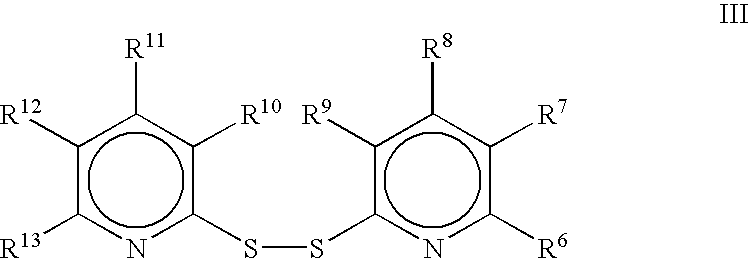Premium wear-resistant lubricant containing non-ionic ashless anti-wear additives
a technology of additives and anti-wear lubricants, which is applied in the preparation of carboxylic compounds, instruments, record information storage, etc., can solve the problems of reducing increasing oil consumption, and increasing particulate and regulated gas emissions, so as to reduce the amount of anti-wear additives and increase the wear resistance of lubricants
- Summary
- Abstract
- Description
- Claims
- Application Information
AI Technical Summary
Benefits of technology
Problems solved by technology
Method used
Image
Examples
example 1
[0081] Wear tests were conducted on seven different lubricating oil base stocks both without any antiwear additive with different levels of non-ionic ashless antiwear additive, thiosalicylic acid. The tests were all conducted in a High Frequency Reciprocating Rig (HFRR) test (ISO Provisional Standard, TC22 / SC7N959, 1995). This test is designed to predict wear performance of diesel fuels. A modified procedure was developed to evaluate the wear characteristics of basestocks with and without antiwear additive. Test conditions include Time=200 minutes; Load=1 kg; Frequency=20 Hz; and Temperature=120° C. In this test, the wear scar diameter of a loaded steel ball is the measure of the wear performance of the lubricant. The repeatability of the HFRR test is +1.0 to 2.0%.
[0082] The lubricating oil base stocks used in the following examples and comparative examples had the following characteristics:
TABLE 1Test4 cSt6 cSt6 cStMethodGroupGroup IIIGroup IIIGroup IIICharacteristic(ASTM)GTL 6P...
example 2
[0086] Wear tests were conducted on two different lube base stocks both without any antiwear additive and with different levels of the non-ionic ashless antiwear additive thiazolidine (unsubstituted). The HFRR test was conducted as outlined in Example 1, above.
[0087] As is shown in Table 3 below, while both base stocks showed an improvement in wear performance when combined with thiazolidine, the GTL base oil / thiazolidine blend showed unexpectedly superior result in wear performance as compared against the result secured in the case of PAO-6 and thiazolidine, over the entire range of thiazolidine used. Though improved over the base case of no additive, the wear scar diameter is noticeably higher in the case of the PAO / additive blend.
TABLE 3ThiazolidineWt %No0.0050.0150.0250.0350.050mmolAdditive0.651.953.254.556.50GTL 6418433420417387366PAO 6486498460442430426
example 3
[0088] Wear tests were conducted on five different lubricating base stocks both without any antiwear additive and with different levels of the non-ionic ashless antiwear additive thioxomalonate (diethylthioxomalonate, R3 and R4 in Formula II are both ethyl, C2H5), under the HFRR list conditions outlined above. In all instances, as shown in Table 4, the formulations showed an improvement in wear performance, the formulations comprising the slack wax isomerate base oil / thioxomalonate additive or the GTL base oil / thioxomalonate additive, at all additive treat levels showing superior improvement in wear performance as compared against formulations which employed PAO-6 or Group I, Group II or Group III base stocks.
TABLE 4ThioxomalonateWt %No0.0120.0370.0620.0870.12mmolAdditive0.651.953.254.556.50GTL 6418410406400376365PAO 6486484465440422410Group I422482431Group II4344704266 cSt Group606441420III**(A)
PUM
| Property | Measurement | Unit |
|---|---|---|
| Temperature | aaaaa | aaaaa |
| Temperature | aaaaa | aaaaa |
| Temperature | aaaaa | aaaaa |
Abstract
Description
Claims
Application Information
 Login to View More
Login to View More - R&D
- Intellectual Property
- Life Sciences
- Materials
- Tech Scout
- Unparalleled Data Quality
- Higher Quality Content
- 60% Fewer Hallucinations
Browse by: Latest US Patents, China's latest patents, Technical Efficacy Thesaurus, Application Domain, Technology Topic, Popular Technical Reports.
© 2025 PatSnap. All rights reserved.Legal|Privacy policy|Modern Slavery Act Transparency Statement|Sitemap|About US| Contact US: help@patsnap.com



